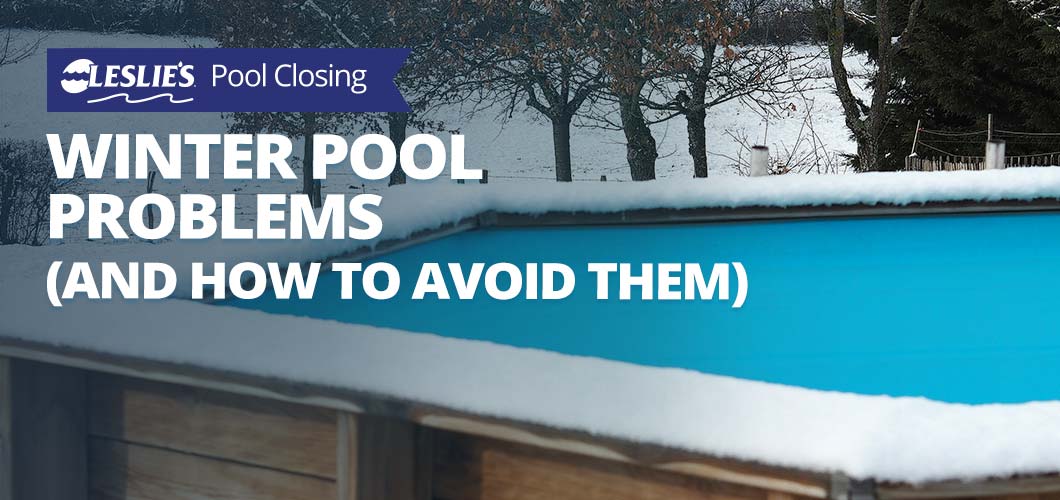
Winter Pool Problems (and How to Avoid Them)
Winter is here! You can finally prop your feet up and forget about pool maintenance for a few months, right?! Well, not quite. The truth is, harsh winter weather conditions, paired with a lack of regular pool care, can severely damage a pool during the off-season months. In this blog, we’ll look at some of the most common cold-weather pool problems. Then we'll help you out with a few winter pool care tips to help you avoid those issues.

Murky Waters
Before you close the pool for the winter, you meticulously clean the pool, balance the water, add algaecide and other winter chemicals, and make sure sanitizer levels are enough to last through the off-season. But when temperatures rise above 60ºF, your pristine swimming pool can quickly become a cesspool if you're not careful. This is especially true if you have a mesh cover, which allows fine particles to filter through. The same can happen if you have cover damage (more on that below). Excess organic debris in the water uses up sanitizer quickly, opening the door for germs and algae to take over.
Although you won't be able to balance pool water until you reconnect the equipment, you can still test and manage sanitizer levels. Add non-chlorine shock or additional sanitizer as needed to maintain clean, healthy water. Just remember to circulate the water with a pool brush or submersible pump when adding any winter chemicals.
If you notice the pool taking on a green hue, or if you notice significant stains and scale buildup, consider bringing a water sample to your local pool store for professional testing and advice. In some cases, you may need to open the pool a little early to keep the problem from getting worse. So how often should you test pool water in the winter?
- If the pool is frozen, leave it alone.
- When temperatures are below 60ºF, test the water at least once per month, or whenever surface ice thaws enough for testing.
- For temperatures between 60–70ºF, test the water every two weeks.
- When the weather consistently reaches 70ºF or higher, test the water once or twice per week. Consider opening the pool.

Cover Catastrophes
Winter pool covers and safety covers are so, so, SO important in maintaining water quality through the winter. Many problems with pool covers stem from cover damage. This damage is usually caused by age, general wear and tear, or holes and tears from animals and large debris.
The problems with damaged covers are plenty. Existing tears grow larger over time, allowing more and more debris to pass through. At some point, the cover can't even do its job anymore, and you'll have no choice but to buy a new one. For solid covers using a cover pump, unpatched holes pack a one-two punch. Water from the pool can get pumped out through the cover pump, which lowers the pool level and puts extra stress on the cover. If the cover fails and collapses into the pool, your pool opening process is likely to be difficult and expensive. Even more so if there was a lot of leafy debris and murky water on top! Follow these simple tips to make sure your pool cover stays in place and the water stays clear all winter.
BONUS TIP: Have a lot of trees around the pool? A leaf net over the top of your pool cover can help you quickly remove leaves and twigs.
- In most cases, you can repair holes with a winter cover patch or a safety cover patch. Fix all holes and tears as soon as possible.
- Keep extra parts on hand in case of emergencies. Cover patches, extra water bags, safety cover hardware, air pillows, etc. are all great to keep around, depending on the type of pool cover you have.
- Regularly and carefully remove debris, including leaves, twigs, and tree limbs. This keeps accumulated water cleaner and minimizes the risk of cover punctures. It also makes cover removal much easier come springtime.
- Use a pool cover pump to remove excess rainwater and snowmelt from solid covers.
- Adjust safety cover straps or winter cover water bags as needed to keep the cover secure.
- DO NOT shift or adjust the cover if there’s a layer of ice on top — this may damage it. Never attempt to break up ice on the cover, either.
- If you notice the pool’s water level getting lower, check to see if there’s a hole in the cover supplying pool water to your cover pump. If not, there’s a good chance you might have a pool leak. Keep reading!

Lurking Leaks
Ah, the dreaded pool leak! Left unchecked, a winter leak can spell disaster for your pool. It could be an existing leak that went unnoticed through the summer, or it could be a new leak caused by freeze damage (see next section). Either way, pricey damages can occur as a result.
As mentioned in the previous section, low water levels will wreak havoc on a pool cover. Lack of support from pool water below may cause a winter cover to collapse under heavy rain, snow, or tree debris.
If a leak goes undetected, inground pools risk “popping” out of the ground, or your walls and deck may suffer severe damages due to water erosion and the effects of the surrounding wet soil. But vinyl pools face even more risks from undetected leaks. Heavy layers of surface ice can shift or slip as water levels drop, ripping the vinyl liner and compounding the existing leak issue. In addition, low water levels may cause vinyl liners to shift, pucker, or pull away from the wall. Preventing permanent damage to your pool is pretty simple:
- Check the pool at least once or twice a month and track changes in water levels.
- If you detect a leak, maintain appropriate water levels by refilling the pool until you can locate and repair the leak.
BONUS TIP: A leaking pool also means you’re losing winter chemicals. Test the water regularly, and add more as needed to keep your pool clean and clear through the winter.

Chilly Casualties
Freezing temperatures are no joke. Improperly winterized pools often sustain costly damage in cold temperatures. As water freezes, it expands by about 9%, which spells "bad news" when water gets trapped in confined spaces like pool pipes, skimmers, and pool equipment. The increasing pressure caused by water expansion will cause water lines to burst and equipment to crack. This damage gets expensive when replacing costly pool equipment and repairing underground lines.
Expanding ice on the surface of an above ground pool can also cause problems, putting outward pressure on the walls and causing irreparable damage. Thankfully, there are several easy ways to protect your pool investment from Old Man Winter.
- Make sure the skimmer(s) and return lines are properly blown out and plugged when closing the pool. Skimmers should also have a collapsible skimmer guard, such as a Gizzmo or SkimGuard, installed to absorb the pressure from ice expansion.
- Use non-toxic pool antifreeze. Even if all return lines are completely free of water, many pool owners like using antifreeze for added protection in case of a failed winter plug.
- Above ground pools should use an air pillow under the cover, which helps break up surface ice and absorb expansion pressure. Don't fill it up all the way, though — leave some room for it to absorb the expansion. If it deflates, immediately replace it with a new one. Inground pools may also use air pillows, if desired.
- In milder climates where you don’t have to fully close the pool, leave the pool pump running whenever freezing temperatures are in the forecast. We recommend using automated freeze protection. But if the power goes out, be prepared to perform an emergency winterization to prevent catastrophic damages.

Final Tips
Winter pool care is significantly less intensive than summer maintenance. However, it’s equally important. We would all like to just throw the cover on and forget about the pool until spring. But as you can see, doing so can cause costly damages.
Winter pool maintenance doesn’t take much. Just remember to check the pool for leaks and damage once or twice a month when you test water chemistry, and assess the cover's condition anytime you’re near the pool. If the pool or the cover need attention, take care of the little problems before they become a bigger issue.
For more information about winterized pool care, call or stop by your local Leslie's store. You can also check out our Winterized Pool Care Guide, which includes a free downloadable checklist for quick reference. Following these essential tips will not only keep your pool safe through the winter, they'll also help you open your pool quicker this spring.